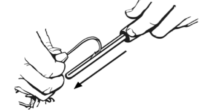1.Type of Blade: The type of blade determines what sharpener is appropriate.
- Straight Edge on both sides (flat grind or double-beveled edge): can be sharpened on most types of sharpeners either one side at a time or both sides simultaneously
- Straight Edge on just one side (k.a. chisel edge): requires a sharpener that allows for sharpening one side of the blade at a time (flat bench stone, precision sharpening system, crock sticks, sharpening rod/steel, or certain electric sharpeners).
- Serrations: requires a tapered diamond or ceramic file or triangular shaped ceramic rods or stones
- Gut Hook: requires a tapered diamond or ceramic rod or file
- Fish Hooks or Pointed Objects (darts, needles, etc.): requires a straight-line sharpening groove
2.Type of Sharpener: The type of sharpener determines your level of success. Some characteristics to consider when purchasing a sharpener are:
- Size
- Sharpening Skill level
- Portability
- Application
A single type of sharpener might do a broad range of knives and tools. Others are designed to sharpen specific types of edges. For example, a flat dimensional stone can be used with knives and a great variety of tools, such as woodworker’s planes and chisels. However, a flat stone cannot be used to sharpen a serrated knife blade or a pair of scissors. Likewise, a tapered rod sharpener will sharpen some serrated edges, but cannot be used to sharpen the woodworker’s tools. A precision guided system will help the unskilled user to hold a constant angle while sharpening a knife, but a skilled user of a flat bench stone can achieve the same results sharpening free-hand. Study the range of sharpener types, consider your skill level, and select the style that most suits your needs and applications.
Manual Sharpeners:
- Fixed angle: great for quick, effective sharpening; ensures the right angle every time
- Flat stone: requires skill or angle guide to ensure correct angle; also good for sharpening small tools such as planes and chisels
- Sharpening Rods & Steels: steels are good for realigning the edge; ceramic and diamond rods will also hone the edge as it realigns
- Precision Systems: guided sharpening systems that hold the knife blade at the correct angle to the sharpener. Precision Systems provide guaranteed results every time.
Electric Sharpeners:
- Great for quickly restoring the edge of very dull knives; especially good if you have a lot of knives to sharpen
3.Sharpening Abrasive Material: There are five major sharpening abrasive categories: Arkansas Stones, Carbides, Ceramics, Diamonds, and Synthetics. Each of these abrasive categories offers its own unique characteristics and sharpening capabilities. No matter what your abrasive preference, all of these products will produce results. The choice really comes down to how much and how quickly you want to remove metal from the blade.
- Diamonds: Because diamonds are the hardest substance known to man, diamond abrasive sharpeners are fast, durable, and very effective. They are very aggressive and remove metal quickly. Diamonds are captured in a nickel plating process to bond with a metal substrate. Premium diamond sharpening surfaces are characterized by a unique interrupted surface that collects and hold the metal filings that ordinarily build-up on the sharpening surface and obscure the diamond abrasive. This allows sharpening with or without honing solution. Excellent for use on very hard tools or stainless steel. Diamond stones always remain flat, as opposed to Natural Arkansas and Synthetic stones which wear down with use, and will even sharpen carbides. They come in multiple grits.
- Carbides: very aggressive; removes metal quickly; great for quickly restoring a good working edge in 3 or 4 strokes.
- Ceramics: removes very little metal; excellent for finishing and maintaining a sharp edge. Can come in different grits, colors, or shapes.
- Arkansas Stones: Arkansas stones are genuine silica “novaculite,” indigenous to Arkansas. They remove the least amount of metal while polishing your edge to razor sharpness; No other sharpener can perform both these tasks simultaneously. They are the best abrasive for honing and polishing an edge to razor sharpness and are known as “the world’s finest finishing stone.”
- Synthetic: man-made stone; great for quick edge setting as well as final finishing. They also come in multiple grits, colors, or shapes.


